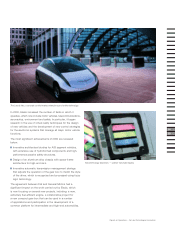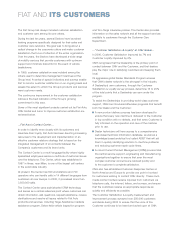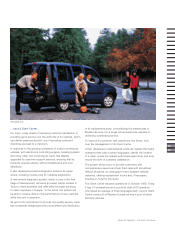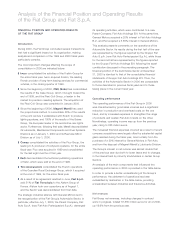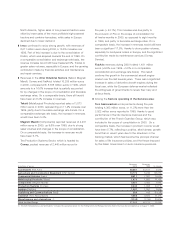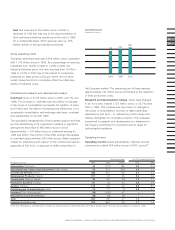Chrysler 2000 Annual Report Download - page 39
Download and view the complete annual report
Please find page 39 of the 2000 Chrysler annual report below. You can navigate through the pages in the report by either clicking on the pages listed below, or by using the keyword search tool below to find specific information within the annual report.
million euros over the previous year. The return on sales
(R.O.S.) of Industrial Activities (excluding Insurance Activities
which are characterized by a structurally negative operating
performance), was equivalent to 1.7%, down slightly from
the 1.9% recorded for 1999.
The improved return on sales resulting from reduced
manufacturing costs and overhead was offset by the
increased research and development and advertising outlays
mentioned above, as well as by a considerable rise
in the cost of some raw materials.
The operating performance of the individual Sectors
is reviewed below:
❚Fiat Auto closed the year with operating income of 44
million euros, compared with a loss of 121 million euros
posted in 1999. The return on sales was a positive 0.2%,
versus a negative 0.5% the previous year.
In spite of strong sales of the new Fiat Punto and Lancia
Lybra models, outlays borne by Fiat Auto to fend off
competitive pressures in Europe held back the Sector’s
profitability. On the other hand, the operating results
for activities in Brazil improved, thanks to a recovery
in demand.
Industrial streamlining in Argentina led to significantly
reduced losses from 1999 levels.
❚CNH Global ended the year with operating income of
45 million euros (0.4% of sales), compared with income
of 371 million euros realized in 1999 for New Holland alone
and 95 million euros (equal to 1% of sales) when Case
income for all 1999 is included on a pro forma basis.
From an industrial and commercial point of view, the
performance of CNH suffered from the previously noted
contraction in volumes, especially in the more profitable
segment of heavy agricultural equipment. The lower
volumes and a shift in demand to lower end of the market,
which were partially compensated for by improved prices,
pulled down the year’s earnings. The operating result
reported by CNH also reflects increased costs for the
amortization of goodwill and other intangible assets
connected with the acquisition of Case.
❚Iveco posted operating income of 489 million euros in 2000
(311 million euros in 1999), which amounted to 5.7% of net
revenues (+1.5 points over 1999). Aside from positive sales
trends and the effects of efficiency measures, this result
reflects a non-recurring real estate gain of 88 million euros
in the fourth quarter of 2000 from the disposal of industrial
areas no longer needed for Sector operations.
Operating income in the Other Industrial Sectors was
positive growing to 386 million euros (+15% over the 336
million euros reported in 1999), and yielding an aggregate
return on sales of approximately 3.8%, in line with the
previous year’s figure.
In particular:
❚Teksid posted operating income of 101 million euros (5.4%
of sales) for the year as a whole, compared with 76 million
euros in the previous year (4.5% of sales). This increase is
partially attributable to currency exchange rates and partially
to considerable cost savings and the favorable impact of
volumes and product mix, which compensated for the
unfavorable relationship between product costs and prices.
❚Magneti Marelli reported operating income of 55 million
euros for the year as a whole (1.2% of sales) compared
with 108 million euros in the previous year. The decrease
is largely the result of changes in the scope of consolidation
following the deconsolidation of businesses that were sold
off, particularly the Lubricants and Rearview Mirror Divisions.
On a comparable basis, the operating result in 2000 would
have been approximately 19 million euros higher than in
1999.
❚Comau reported operating income of 87 million euros
in 2000, equal to 3.6% of revenues, up from the previous
year both in absolute terms and in terms of profitability (43
million euros in 1999, equal to 2.5% of revenues), thanks to
higher volumes on orders in Europe, growth in the Comau
Service Division and the consolidation of Pico Group
activities for the entire year.
❚FiatAvio posted operating income of 143 million euros
(9.6% of sales) in 2000, compared with 109 million euros in
1999 (8% of sales). The improvement in FiatAvio operating
margin was due both to favorable exchange rates and to
the completion of industrial streamlining programs carried
out by the Sector, confirming the company’s strong strategic
position in its field.
The performance of the Other Sectors is reviewed below:
❚Toro Assicurazioni reported a negative operating result
of 56 million euros, which represents an improvement over
1999, when a loss of 103 million euros was reported. Income
before taxes, which is the most representative measure of
profitability for companies operating in the insurance
business, amounted to 163 million euros in 2000, 15 million
euros less than in 1999. It includes a provision of 24 million
euros set aside as a conservative measure in connection
with an administrative penalty levied for alleged violations
of antitrust laws. The Company is appealing the penalty.



